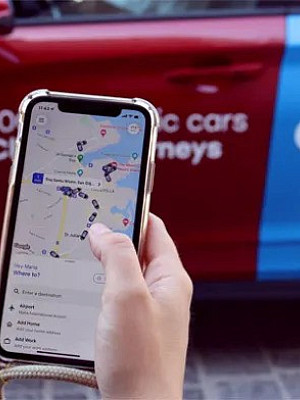Meeting Rome2rio customer needs with Google Maps Platform
Travel planning can be complicated, especially if you combine different modes of transportation such as air, rail, and bus. Travelers may search a wide range of websites to plan or book a trip from door to door. Rome2rio helps travelers save time and hassle to get from point A to B with its one-stop travel search engine.
“We started using Google Maps Platform from day one to help travelers search and compare the best travel routes,” says Craig Penfold, Chief Technology Officer at Rome2rio. “We deliver fast and reliable search results by combining the rich location data from Google Maps Platform with our expanding transport database and a proprietary search algorithm.” The company uses Geocoding API and Distance Matrix API, together with a host of other Google Maps Platform features and APIs in its solution.
“Google Maps Platform delivers high speed, performance, and availability to meet our customer needs,” says Ash Verdoorn, Head of Engineering at Rome2rio. “We’ve tested and evaluated other platforms, but we’ve yet to find one that’s comparable.”
Rome2rio collates transport and fare information from more than 5,000 companies, including airlines and hotels, as well as train, bus, ferry, taxi, and rideshare operators. Developers add the transit data as a map layer on top of Google Maps Platform to improve search relevance. Using Rome2rio’s search engine, travelers can query more than two million travel destinations and make informed decisions based on travel time and pricing.
“Travelers are increasingly mobile-first. 68% of our traffic comes from mobile devices,” says Craig. “Using responsive Google Maps, we deliver a consistent user experience, regardless of device or screen size.”
“From a developer perspective,” adds Ash, “Google Maps Platform is a widely used map service. It takes minimal effort to onboard new developers because Google Maps Platform APIs are well documented.”
Apart from organic traffic, Rome2rio also drives awareness through SEO by creating “travel guide” landing pages for popular destinations, such as the Amsterdam to Paris travel guide. The company develops these lightweight landing pages with Maps Static API to embed a Google Maps image with the search parameters. The maps are cached in Rome2rio’s server and load in milliseconds. That means visitors can see search results quickly once they click on the landing page.
In a page-speed report by Unbounce, nearly 70% of shoppers revealed that page speed impacts their willingness to buy from an online retailer. According to another online retail survey, a one-second delay in mobile load times can impact conversion rates by up to 20%.
“Our web application Rome2rio is a dynamic environment where we can answer queries on how to get anywhere in the world,” says Craig. “Using Maps Static API, we offer the same context on a lighter solution to improve user experience.”
Creating optimized landing pages to capture customer attention
Apart from optimizing Google Maps to accelerate page load speed, Rome2rio also prioritizes the content on the landing page. The landing page reflects the branding of the homepage but doesn’t contain all the page elements. Visitors see high-level results such as duration and distance. If they click on the static map, they see a dynamic map with interactive components that gives visitors a better view of how to get to their destination.
“People get frustrated and leave if they encounter a slow site,” says Craig. “Customers are more likely to explore our website if the landing page loads faster.”
“In terms of development time, static map pages are easy to deploy,” adds Ash. “We’re able to automatically generate new pages based on popular searches, in a matter of hours, rather than days.”
Improving search results for global travelers
Although Rome2rio is based in Melbourne, Australia, the company experiences the biggest usage from Europe and the U.S. Dealing with a global audience means that the company needs to understand the nuances of each market.
For example, a non-European traveler might type in “The Louvre” for the iconic museum in Paris, instead of the correct local term, “Musee du Louvre.” Rome2rio uses Place Autocomplete to reduce time and improve accuracy in search results. When a traveler starts typing an address, Autocomplete, a feature of Places API, offers a list of suggestions. Rome2rio’s travel search engine can retrieve and display relevant search results, even if the user leaves out a component of an address or a location. If a user types “Tokyo airport,” both Tokyo Narita Airport and Tokyo Haneda Airport appear in the results.
“We developed our own code to match address and search terms but struggled to keep up with variant spelling as we support six languages,” says Ash. “By using Place Autocomplete, our visitors are more likely to find what they’re looking for even if they make a mistake in their input.”
Uncovering data insights to deliver a customer-focused experience
Rome2rio processes around five terabytes of data each day, from transit feeds to customer interaction data on its website and mobile applications.
The company uses BigQuery for strategic planning and also for travel insights for use in informative reports such as 2018 Global Flight Price Ranking. For the report, Rome2rio’s data scientist team examined economy class airfares displayed by Rome2rio over a period of four months to rank airlines by average price per kilometer. By reading the report, customers find out which airline offers the best value for their money.
“By analyzing data, we can understand what our customers are looking for and provide them with the right answer,” says Ash. “If we see more customers searching for a particular location, we use Maps Static API to automatically add those pages to boost traffic and partner revenue.”
“BigQuery is a managed solution, so our developers don’t need to spend time and effort maintaining the infrastructure,” says Craig. “It’s important that BigQuery is highly scalable to analyze tens of millions of data points on our site each day.”
Future plans
Rome2rio is constantly seeking new ways to meet the demands and expectations of travelers who use its service. The company records that on iOS devices alone, 3,000 screenshots of Rome2rio content are taken each day, which clearly indicates that people want to look at their travel information and options while not necessarily connected to the internet. Acting responsively to this valuable insight, Rome2rio now plans to help travelers access offline data on its app, taking its travel booking engine even further with information that’s available at its customers’ fingertips anytime, anywhere.


